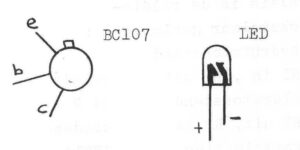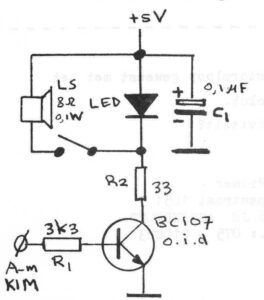KIM Kenner 10 March 1980, Dutch article by Hans Otten, English translation Hans Otten, 2021
Having an indication of how the reading and writing to the cassette recorder is going is nice. With the Micro Ade routines the LED display is used for this. the standard KIM-1 routines are mute.
This small hardware circuit gives either a visual or audible indication with the standard KIM-1 routines.
How does it work?
An indication for for the read process is the output signal of the PLL circuit, a stream of digital pulsed delivered at PB7 of the RRIOT 6530-002. During the reading pin PB7 is rpogrammed as input, during the wirte it is an output. Via a buffer the output signal signal is brought to Audio-Out and Audio-Out-High.
The use of PB7 as input and output during the read and write process means that during a read the decoded signal appears on Audio Out, and as it is meant to be, during writing also has the output signal. Collision is prevented by blocking the input signal during writing. So this means that during reading and during write the signal is present on Audio-Out. This enables a indication of both read and write processes.
The signal on Audio-Out (application connector A-M) is brought to a transistor (general purpose type) and the alternating signal makes the LED blink quite fast. A miniature loudspeaker can be switched in and the signal can be heard, it is in the hearable audio range. The LED is not very informative, the loudspeaker is, but also can be annoying, so the switch is welcome.
Do not use a lower value than 33 ohm for R2, it will damage the transistor. The circuit does not represent a heavy load, so you can use the KIM-1 power supply.
Construction
A piece of stripboard is sufficient. See the figure below for the connections of transistor and LED. Red, green, yellow can all be used.
Other usage
By programming the output PB7 music or signals can be heard.


